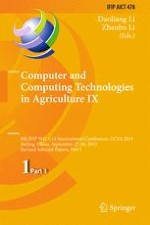The two volumes IFIP AICT 478 and 479 constitute the refereed post-conference proceedings of the 9th IFIP WG 5.14 International Conference on Computer and Computing Technologies in Agriculture, CCTA 2015, held in Beijing, China, in September 2015. The 122 revised papers included in this volume were carefully selected from 237 submissions. They cover a wide range of interesting theories and applications of information technology in agriculture, including intelligent sensing, monitoring and automatic control technology; key technology and models of the Internet of things; intelligent technology for agricultural equipment; computer vision; computer graphics and virtual reality; computer simulation, optimization and modeling; cloud computing and agricultural applications; agricultural big data; decision support systems and expert systems; 3s technology and precision agriculture; quality and safety of agricultural products; detection and tracing technology; and agricultural electronic commerce technology.
